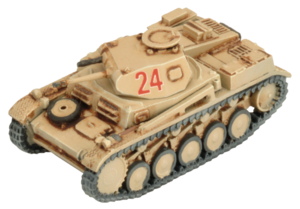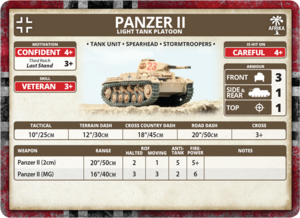Panzer II: Difference between revisions
(Undo revision 799463 by Lord Of The Lemmings (talk) It seems to be: https://www.flamesofwar.com/hobby.aspx?art_id=5645) |
1d4chan>Rocko1345 No edit summary |
||
| Line 1: | Line 1: | ||
[[File:Panzer II Mini.png|thumb|"2 can be as bad as one, the loneliest number since the number 1.."]] | |||
The Panzer II was a an early tank design that served as the basis of the Wespe Self-Propelled Howitzer and the Marder II. It was the most numerous tank deployed during the Invasions of Poland and France. | The Panzer II was a an early tank design that served as the basis of the Wespe Self-Propelled Howitzer and the Marder II. It was the most numerous tank deployed during the Invasions of Poland and France. | ||
==Early War== | |||
[[File:Panzer II Statcard.png|thumb|left|Die Stats]] | |||
==IRL== | ==IRL== | ||
Revision as of 09:42, 12 January 2022

The Panzer II was a an early tank design that served as the basis of the Wespe Self-Propelled Howitzer and the Marder II. It was the most numerous tank deployed during the Invasions of Poland and France.
Early War

IRL
The Panzer II started out as a stopgap solution, originally developed to help German Industry gain its footing after the Great Depression. These Panzers were built to help the industry gain experience building tanks and build enough capital to start building the Panzer IIIs.
In the early 1930's, the Panzer II was able to resist any AT gun that existed at that moment, but itself was equipped with a puny 20mm Cannon that would be useful against trucks and nothing else. By 1939, while this advantage had somewhat eroded, they were availble in great numbers and worked well with German Blitzkrieg warfare, which favored mobility. By 1940, the writing on the wall was clear, and all mainline variants were withdrawn following the battle of France, instead placed in support, recon, and training roles.
About a dozen variants and subvariants of the vehicle exist, including Flame tanks, but one of the more famous ones was the "Luchs" (Lynx), which served as a recon vehicle and had a 2 cm Autocannon strapped to it. Notably, it was also able to achieve speeds of up to 60 KPH (37 MPH) and despite only 100 being built, the vehicle was popular among the crews that used them.
| German Forces in Flames of War | |
|---|---|
| Tanks: | Panzer II - Panzer III - Panzer IV - Panther - Tiger - Tiger II - Panzer 38(t) - Captured Tank Platoon (Germany) |
| Transports: | SdKfz 250 - SdKfz 251 - Opel Blitzwagen |
| Infantry: | MG34 Platoon - AT-Rifle Team - Assault Pioneer Platoon - Grenadier Company - Fallshirmjager Company |
| Artillery: | PaK-40 Anti-Tank Gun - Hummel - Panzerwerfer 42 - Wespe - Grille - PaK-43 - 12cm Mortar - 8cm Mortar - 21cm Nebelwerfer 42 - 30cm Nebelwerfer 42 |
| Tank Destroyers and Assault guns: | Marder - StuG III - Jagdpanzer IV - Nashorn - Elefant - Jagdtiger - Brummbar - Hetzer - Sturmpanzer II Bison |
| Armored Cars: | SdKfz. 234/2 'Puma' - Sd.Kfz 222/223 - SdKfz. 231 |
| Aircraft: | JU-87 Stuka - HS-129 - ME-262 Sturmvogel |
| Anti-Aircraft: | Flak 88mm - Flakpanzer IV Wirbelwind & Ostwind |